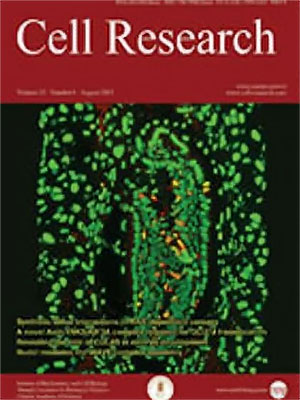
Volume 13, No 5, Oct 2003
ISSN: 1001-0602
EISSN: 1748-7838 2018
impact factor 17.848*
(Clarivate Analytics, 2019)
Volume 13 Issue 5, October 2003: 351-359
ORIGINAL ARTICLES
The in vitro reconstitution of nucleosome and its binding patterns with HMG1/2 and HMG14/17 proteins
SHU BING ZHANG1*, JIAN SHU BING ZHANG1*, JIAN XIAO DONG CHENG1, CHU JIANG1, MIN QIAN LI2, JUN HU2, RUO LAN QIAN1**
1Group of Globin Gene Expression and Regulation, State Key Laboratory of Molecular Biology, Institute of Biochemistry and Cell Biology, Shanghai Institutes for Biological Sciences, Chinese Academy of Sciences, Shanghai 200031,China. E-mail:qianlab@sunm.shcnc.ac.cn
2Shanghai Institute of Nuclear Research, Chinese Academy of Sciences, Shanghai 201800, China
Correspondence: Ruo Lan(qianlab@sunm.shcnc.ac.cn)
Using atomic force microscopy (AFM), the dynamic process of the in vitro nucleosome reconstitution followed by slow dilution from high salt to low salt was visualized. Data showed that the histone octamers were dissociated from DNA at 1M NaCl. When the salt concentration was slowly reduced to 650 mM and 300 mM, the core histones bound to the naked DNA gradually. Once the salt concentration was reduced to 50 mM the classic "beads-on-a-string" structure was clearly visualized. Furthermore, using the technique of the in vitro reconstitution of nucleosome, the mono- and di- nucleosomes were assembled in vitro with both HS2core (-10681 to -10970 bp) and NCR2 (-372 to -194 bp) DNA sequences in the 5'flanking sequence of human b-globin gene. Data revealed that HMG 1/2 and HMG14/17 proteins binding to both DNA sequences are changeable following the assembly and disassembly of nucleosomes. We suggest that the changeable binding patterns of HMG 14/17 and HMG1/2 proteins with these regulatory elements may be critical in the process of nucleosome assembly, recruitment of chromatin-modifying activities, and the regulation of human b-globin gene expression.
FULL TEXT | PDF
Browse 2066


